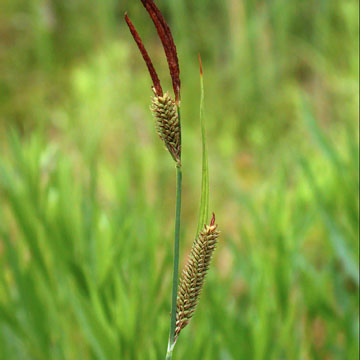

Carex haydenii - (image 1 of 6)
Taxonomy
Family: Cyperaceae
Section Phacocystis
Habitat
Wet meadows, wet open woods.
Associates
Distribution
New Brunswick to MN and SD, south to NJ, PA, IN, and MO.
Morphology
Tufted perennial; stems slender, arising laterally, scabrous on the angles, 50-120 cm, usually much longer than the leaves; lowest leaves reduced to dark reddish-brown bladeless sheaths; main leaves 2-5 mm wide; sheaths glabrous, dorsally green, concave and red-dotted at the apex; lowest bract leaf-like, usually slightly shorter than the inflorescence, the other much reduced; staminate spikes 1-3, the terminal one 2-5 cm, the other much smaller; pistillate spikes 2-3, ± sessile, erect, separate or somewhat overlapping, 1-5 cm, linear-cylindric, the uppermost with some distal staminate flowers; pistillate scales with green midvein and dark brown sides, narrow than the perigynia, long-acuminate and projecting 0.5-1.5 mm beyond them; perigynia 1.5-2.5 mm, olive-green with red dots, biconvex, rounded-obovoid and slightly inflated, rounded above to a minute beak, with 1-2 faint veins on each side; achene lenticular.
Notes
Fruiting May to June.
Wetland indicator: OBL
Similar to C. stricta, from which it differs in having the inflorescence well surpassing the leaves and scales distinctly longer than the perigynia. Both species have ladder-fibrillose basal sheaths but this characteristic much less pronounced in C. haydenii.
References
Gleason, Henry A. and A. Cronquist. 1991. Manual of Vascular Plants of
Northeastern United States and Adjacent Canada. Second Ed.
The New York Botanical Garden. Bronx, NY
|
© Michael Hough 2018 |